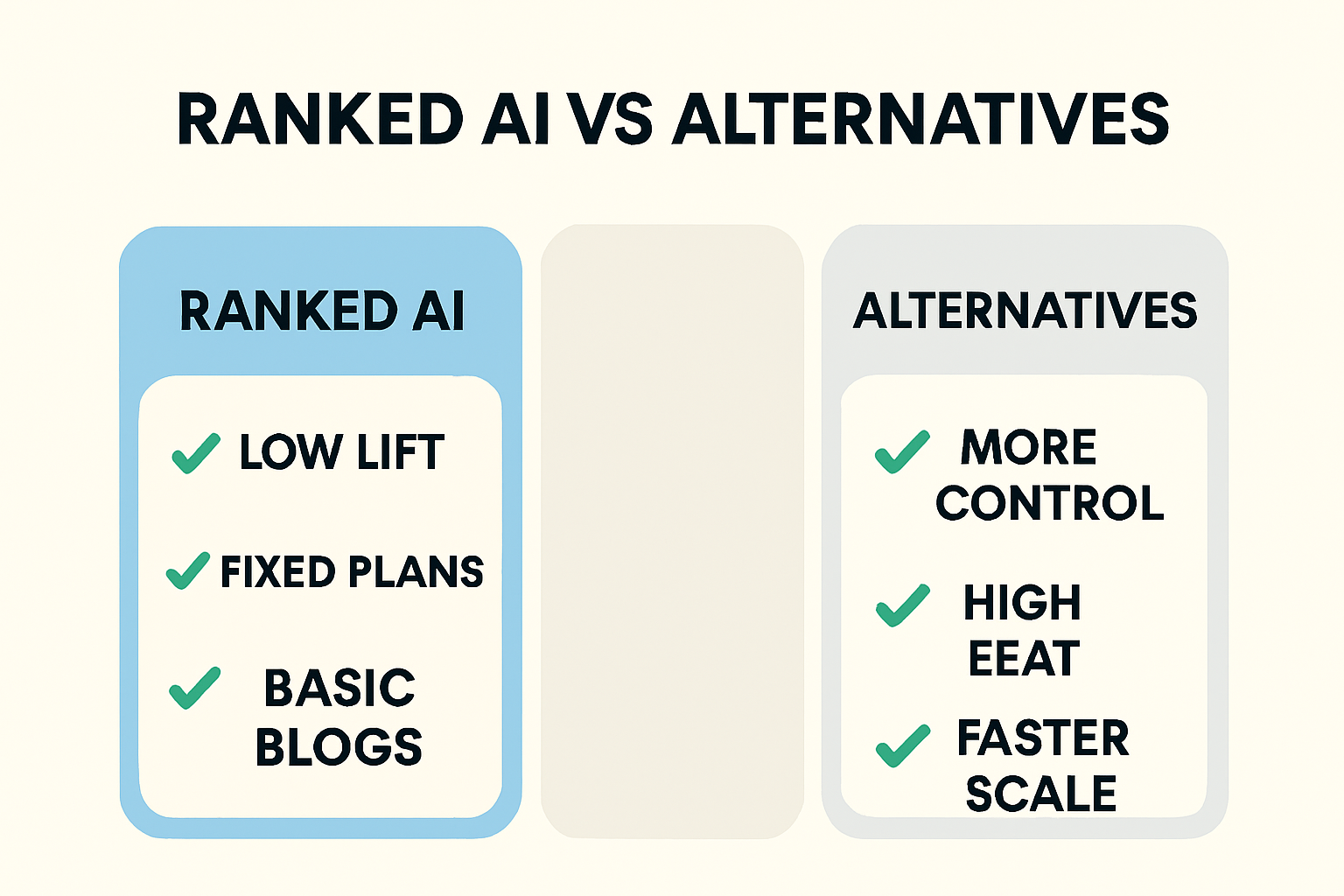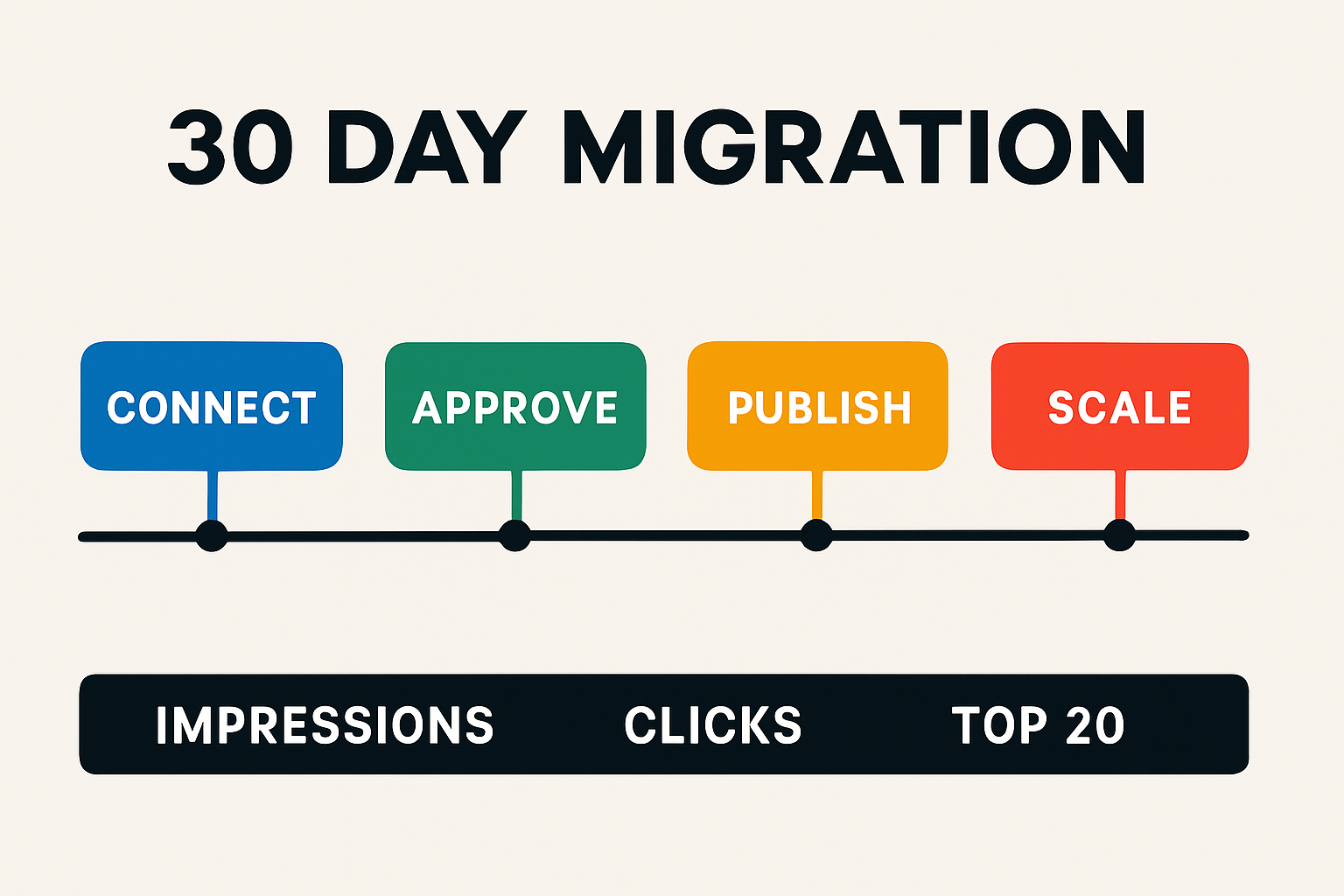Skimming ranked.ai reviews and wondering if it’s the right path to rank in 2025? With AI Overviews reshaping SERPs and CTRs shrinking, your SEO content engine must be fast, credible, and consistent. This guide summarizes what reviews say, when to choose an alternative, how to evaluate platforms, and why SEOsolved is our Editor’s Pick—with a 30-day migration plan and checklists you can use today.
Snapshot: What ranked.ai reviews say in 2025
Public ranked.ai reviews generally describe a hands-off AI content and backlink service with tiered pricing, predictable deliverables, and minimal management. Buyers like the convenience and cost compared to agencies, but some explore alternatives when they need more control, deeper E-E-A-T, or strategy automation at scale.
- Pros commonly noted: set-and-forget blogging, budget-friendly tiers (e.g., plans from $99–$349/month), and white-hat outreach for links.
- Cons occasionally raised: limited editorial control, variable depth on complex topics, and difficulty optimizing for AI Overviews without extra strategy layers.
Context matters: AI Overviews now occupy major SERP real estate and have reduced CTRs for classic rankings, so teams often look for alternatives that optimize for both Google and AI assistants with strong sourcing and internal linking.
Sources: ranked.ai pricing and outreach details appear in public reviews; search behavior changes documented by industry research (see links throughout).

When Ranked.ai fits—and when to choose an alternative
This section helps you self-identify whether Ranked.ai matches your use case or if a different AI blogging solution will deliver more ROI.
Good fit scenarios
- Hands-off blogging: You want consistent publishing with minimal management.
- Basic SEO content: You run a small site testing content velocity and simple topics.
- Entry-level AI content: You’re exploring AI-generated posts before committing to a fuller stack.
- Budget-first approach: Predictable monthly fees matter more than advanced controls.
Signs you need an alternative
- Competitive niches: You need strategy automation, keyword clustering, and superior on-page depth to win.
- Stronger E-E-A-T: You require credible citations, expert input, and clear author signals.
- Faster iteration: You want tight brief controls, brand voice, and rapid revision loops.
- Multi-site scale: You manage several domains and need 30–60 in-depth articles each month.
- AI search visibility: You must optimize for AI Overviews and assistant answers, not just blue links.
US buyer considerations
- Compliance & sourcing: Favor platforms that cite authoritative sources and support fact-check workflows.
- Localization: Ensure US English, measurements, and regulatory nuances are reflected in content.
- Attribution: Require author bios, organization schema, and linkable references for trust.
How to evaluate Ranked.ai alternatives (2025 criteria)
Use this repeatable framework to compare ranked.ai vs competitors before you switch.
Strategy automation and keyword discovery
Look for automated competitor analysis, keyword clustering, and content roadmaps that map search intent. Your platform should surface 100s of keywords with internal linking recommendations in minutes—not weeks. For deeper context on automation, see AI Competitor Analysis: Automate Insights in 7 Steps.
Content quality, E-E-A-T, and sourcing
Definition for quick evaluation: High E-E-A-T content demonstrates first-hand expertise, cites credible sources, and attributes authorship clearly. Prefer systems that automatically include citations and prompt experts for light reviews. As SERPs evolve, trust signals and factual integrity are non-negotiable.
On-page optimization and internal linking
- Structured H2/H3 hierarchy and semantic coverage of entities.
- Schema markup (Article, Author, Organization) and FAQ where relevant.
- Automated internal link suggestions to accelerate indexing and topical authority. For deeper technique, skim Semantic SEO: The Fast Track to Unshakable Authority.
Velocity and consistency at scale
Ask for realistic, sustainable output. Many teams see compounding gains at 30–60 in-depth articles/month when the cadence is consistent and quality remains high.
Workflow control and editing
- Brief controls: target keywords, intent, entities, internal links.
- Brand voice: tone presets and examples.
- Approvals: staged drafts, comments, and change history.
Pricing transparency and ROI
Calculate effective cost per article and time saved. Include your internal time (briefing, editing, uploading) and every tool subscription. For a buyer’s landscape, see AI writing tools that rank in 2025.
Best Ranked.ai alternatives for 2025 (shortlist)
Below are vetted options, starting with the strongest fit for product-aware buyers who want automation plus E-E-A-T.
SEOsolved (Editor’s Pick)
- Best for: Teams needing fully automated strategy + generation with credible sourcing and minimal management.
- Standout: From a URL, discovers 500+ keywords, builds a content roadmap, and publishes 30–60 in-depth articles/month.
- Why it matters in 2025: Optimizes for Google and AI assistants as AI Overviews reduce CTR for traditional results.
- Effort: ~10 minutes/week, reclaim 80+ hours/month.
Start Ranking Today with SEOsolved or explore how automation scales output in our guide: Automated Content Creation: Scale SEO Fast in 2025.
Scalenut
- Best for: Teams wanting guided control via topic clusters and SERP analysis.
- Tradeoff: More manual steps vs. fully automated platforms.
Jasper + Surfer SEO (combo)
- Best for: Manual control, brand tone, and on-page optimization using separate tools.
- Notes: Jasper’s tiered pricing can start around $39/month; Surfer provides optimization suggestions.
- Tradeoff: You own the workflow but spend more time stitching tools and briefs.
Content at Scale
- Best for: Long-form generation and batch publishing.
- Tradeoff: Ensure adequate editing to maintain E-E-A-T.
Outranking
- Best for: Strong brief generation and SERP-aligned outlines.
- Tradeoff: Manual execution still required to hit volume.
GrowthBar
- Best for: Lean teams and startups needing simple keyword research and AI drafting.
- Tradeoff: Lighter on advanced strategy automation.
Writesonic (Chatsonic)
- Best for: Fast drafting and multi-format content for marketing teams.
- Tradeoff: Expect extra time for on-page fine-tuning.
Clearscope + human writers
- Best for: Optimization-first process while keeping human-led drafts.
- Tradeoff: Higher internal effort but granular control over quality.
Why SEOsolved is the top Ranked.ai alternative
ranked.ai reviews highlight convenience. SEOsolved retains that low lift but adds strategy automation, credible sourcing, and AI search visibility—key for 2025.
Zero-setup strategy: 500+ keywords from competitor analysis
Paste your URL, and SEOsolved maps competitors, clusters keywords, and outputs a prioritized content roadmap automatically—no manual spreadsheets. See how this works in practice in our automation framework.
30–60 high-quality articles every month
Consistent, in-depth output compounds rankings and internal link equity. Expect structured headings, entities, and interlinking baked into every post for sustainable growth.
Credible sources and E-E-A-T baked in
SEOsolved includes citations and attribution to support factual integrity. That’s critical as Google and AI assistants elevate answers with clear sourcing and expert signals.
Rank on Google and AI assistants
With AI Overviews taking substantial screen space on mobile and desktop, SEOsolved optimizes content and schema for both classic SERPs and answer engines—boosting odds of visibility even as traditional CTRs decline.
10 minutes a week, reclaim 80+ hours a month
Light approvals and batch publishing save serious time compared to stitching together multiple tools and writers.
Transparent ROI and simple onboarding
Clear deliverables, measurable KPIs, and a fast setup help you reach break-even sooner.
Pricing, ROI, and break-even math
Use effective cost-per-article and time saved to compare platforms. Include tool subscriptions, writer/editor hours, and publishing overhead.
DIY stack vs. SEOsolved
| Approach | Typical Monthly Cost | Output | Time Investment | Who It’s For |
|---|---|---|---|---|
| DIY tool stack + freelancers | $1,500–$5,000+ (tools, briefs, writing, editing) | 8–20 articles | 20–60 hrs | Teams wanting granular control |
| SEOsolved (automated) | Predictable platform fee | 30–60 in-depth articles | ~10 min/week | Startups, SMBs, and brands prioritizing scale |
Tip: If your blended internal rate is $75/hour, saving 40 hours/month equals $3,000 in opportunity cost—often eclipsing platform fees.
Agency retainer vs. SEOsolved
- Agency retainer: High-touch strategy and content, but limited bandwidth and higher costs.
- SEOsolved: Automated strategy + volume with credible sourcing and on-page standards.
Break-even scenarios by business size
- Startups: Break even when 3–5 non-brand conversions/month cover platform fees.
- SMBs: Positive ROI when cost/article drops below your current blended rate.
- Growing brands: Win on scale—compounding internal links and coverage create durable gains.
30-day migration plan: Move from Ranked.ai to SEOsolved
Follow this low-friction switch plan to protect momentum and accelerate results.
Days 1–3: Connect URL and import context
- Connect your site URL; add competitors and goals.
- Import existing posts to avoid cannibalization and guide interlinking.
- Run the initial crawl and keyword discovery.
Week 1: Approve roadmap and brand voice
- Review clusters, search intent, and priority order.
- Lock tone, personas, and entity coverage. Use our brand voice pointers if helpful.
- Set internal link standards and schema defaults.
Week 2: First 10–15 articles live
- Publish the first batch; verify on-page SEO and citations.
- Add images, FAQs, and internal links as needed.
- Spot-check accuracy and align with product positioning.
Week 3–4: Scale to full cadence
- Ramp to 30–60 posts/month with monitoring and iteration.
- Expand clusters, refresh early posts, and reinforce internal links.
Metrics to watch
- Impressions and indexed pages (leading indicators)
- Non-brand clicks and top 20 keyword count
- Pages earning AI Overview mentions or featured snippets

Implementation checklists and test prompts
Content brief template
Copy these fields into your briefs to keep outputs consistent:
- Intent and primary keyword; supporting entities and questions
- Target reader and stage; must-include subtopics
- Outline (H2/H3), internal link targets, and external sources to cite
- Brand voice examples and do/don’t list
On-page SEO checklist
- Title tag includes primary keyword; compelling and under ~60 chars.
- H2/H3 mirror intent; entities and FAQs covered.
- Schema (Article, Organization, FAQ) where relevant.
- 2–4 internal links to relevant pages; 1–3 credible external citations.
- Compressed images with descriptive alt text.
Brand voice prompts
Paste into your tool to enforce tone consistency:
- “Write in a confident, helpful tone for US SMBs. Short paragraphs. Bold key phrases. Keep jargon minimal.”
- “Mirror these examples for rhythm and vocabulary: [paste 2–3 brand-approved paragraphs].”
Fact-check and citation workflow
- Highlight every claim or stat; add source links from authoritative publications.
- Verify dates and context; prefer primary research or reputable analyses.
- Add author bylines and organization schema; include last-updated date.
Need a scalable system to execute all of the above with minimal lift? Start Ranking Today with SEOsolved.
FAQs inspired by ranked.ai reviews
Is AI-generated content safe for SEO in 2025?
Yes—when it’s high quality, original, and user-first. Use citations, clear attribution, and strong on-page optimization. Prioritize value over volume.
How fast can I expect results?
Most sites see leading indicators (impressions, indexing) in weeks; competitive rankings can take 2–4 months depending on cadence, competition, and technical health.
Do I still need a human editor?
Light editorial review is smart for tone, accuracy, and compliance. Many teams run a quick human-in-the-loop pass before publishing.
What about sourcing and E-E-A-T?
Use credible citations, expert quotes, and author bios. Platforms like SEOsolved incorporate sourcing and attribution to support trust signals.
Final verdict and next step
If you want hands-off, budget-friendly blogging, Ranked.ai can fit. If you need strategy automation, stronger E-E-A-T, AI search visibility, and 30–60 in-depth posts/month, an alternative like SEOsolved will likely deliver more ROI. Ready to compound rankings with credible, automated content?
Try SEOsolved to automate strategy and scale content
Start Ranking Today—connect your URL, approve your roadmap, and publish your first batch this week.
Further reading: Learn how to scale and govern quality at speed: Automated Content Creation: Scale SEO Fast in 2025.
Citations and supporting research
- AI Overviews’ impact on CTR and screen real estate: analysis by Single Grain.
- Ranked.ai pricing and white-hat outreach summary: public reviews.
- Tool landscapes and pricing references: reputable educational and analyst sources.
